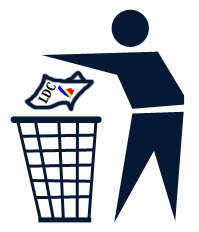Earlier this month, Peoria County administrators crunched the pro forma numbers submitted by the Museum Collaboration Group and found that it was a money-losing proposition. The museum folks objected to that analysis, saying it wasn’t accurate. They got together with the County and re-crunched the numbers, and now the County shows the museum will make a tidy profit.
Erik Bush, the County’s Chief Financial Officer explains what changed:
The first analysis actually showed a dire projection. When discussing the revenues with PRM staff, it became clear that in developing their background materials, PRM had established discounts on their revenue projections, from which I assumed as 100% projections. In reality, these numbers were in some cases 70% of their true projections. In tum, I was discounting discounted figures. A line by line narrative of these changes may be found at the end of this memorandum.
I asked PRM to provide me with the 100% revenue estimates and proceeded to run the second iteration.
The results are summarized as follows:
a. Based on the PRM’s assumptions, their projections could be off up to 9% and still operate in the black over a 20-year period.
b. In using their 100% revenue projections it appears revenues annually meet or exceed 100% of expense projections. The margin of actual to budget has historically been 1-2%; therefore, I find a 9% cushion to a structural deficit reasonable.
c. A key item missing from their pro-forma is the cost of future capital investment. A common benchmark for capital investment is 10%. Based on an expected expense base of slightly more than $4 million, it can be reasonably expected the museum is not showing close to $400,000 in potential annual future costs to properly maintain its assets. This figure is a benchmark and can be driven by annual needs.
d. In the 100% scenario, roughly $100k of the endowment will be necessary to cover the cost of capital investment and break even annually. In the 95% scenario, an endowment ofroughly eight million dollars would be needed to generate the necessary interest (assuming 4% annual return, compounded monthly) to cover the annual cost of capital investment, combined with the projected excess of revenues over expenditures.
The changes are all well-argued, but I still have a problem with a couple of key assumptions:
- Gallery admissions still based on projected 240,000 visitors per year. On their pro forma, the museum changed some parameters: they raised the average ticket price from $5.25 to $7.50, and they assumed 40% of the 240,000 visitors to the museum would buy a gallery admission, up from 33%. Those changes raised their projected revenue for gallery admissions from $420,000 to $718,000. However, if we use a more realistic estimate of 180,000 visitors per year, the revenue would be $540,000 — $178,000 less than the county/museum projection.
- Planetarium tickets and attendance projected to go up. I’m stumped as to how the museum folks think they’re going to raise the admission price for the planetarium from $1.50 to $4.00 per student, yet end up having more students (19,000 vs. 16,000) visiting the planetarium, especially with schools in as bad of financial shape as they are these days. Nowhere do they explain how they came up with their number of students or how their number compares with historical attendance numbers. In my opinion, they have to assume at the very least that the number of students won’t increase. So take 16,000 students times $4 and you get $64,000, $12,000 less than the county/museum projection.
So, that’s a total difference of $190,000 from the proposed pro-forma, which would bring their projected revenues down to $4,298,000. That would still cover their projected expenses, but would only give them about a 4% cushion instead of 9%. Also, it would mean they’d have to use roughly $270,000 of their endowment for capital investment instead of $100,000. I don’t know how big of an endowment that would require, but to get $303,750 interest earned takes $6,750,000 of investable funds according to the previous pro-forma analysis available at the county’s website. Do they have that much in their endowment?
Here’s the other thing. The money raised by a county sales tax would have to go toward capital purchases, according to the statute:
For the purposes of this Section, “public facilities purposes” includes, but is not limited to, the acquisition, development, construction, reconstruction, rehabilitation, improvement, financing, architectural planning, and installation of capital facilities consisting of buildings, structures, and durable equipment and for the acquisition and improvement of real property and interest in real property required, or expected to be required, in connection with the public facilities, for use by the county for the furnishing of governmental services to its citizens, including but not limited to museums and nursing homes.
If the museum doesn’t meet their revenue projections, I think it’s logical to expect them to scrap the capital investment fund, especially since they didn’t have it in their pro forma in the first place. Without infusions of capital, the place will get out of date pretty fast, and then you know what will happen? They’ll be back asking the taxpayers for more county tax money under this statute for “durable equipment” and “improvement[s].” And then the taxpayers will really be over a barrel because the project at that point will be “too big to fail,” if you know what I mean.
I still believe that a more compact, urban design would be significantly less expensive to build while still being an attractive civic building, plus it would free up the rest of the block (outside of Caterpillar’s visitor center, of course) for private development (retail, residential components), which will bring in property and sales tax dollars to the city and county. Plus, it would be what the public said they wanted on that block, and what professional city planners over the past several decades have said is needed on that block. Why is this option not being pursued?
County board member Merle Widmer has written extensively on the topic of the museum. I encourage everyone who’s interested in this topic to take a look at his blog, Peoria Watch.
The county votes tonight (County Board Room 403, 6:00 p.m.) on whether to put a sales tax referendum on the April ballot. No other counties of which I’m aware are planning similar measures to support this “regional” museum.
 I have to laugh whenever I hear Comcast commercials “warning” people that satellite TV service may pixellate or completely lose its signal when there’s inclement weather. I laugh because Comcast can do that in all types of weather! Not only that, some channels may disappear because they’ve moved them from an analog channel to a digital one. And if you call to complain, you don’t get to talk to anyone locally, you have to call an 800 number and deal with some completely unhelpful wage slave in Who-knows-where.
I have to laugh whenever I hear Comcast commercials “warning” people that satellite TV service may pixellate or completely lose its signal when there’s inclement weather. I laugh because Comcast can do that in all types of weather! Not only that, some channels may disappear because they’ve moved them from an analog channel to a digital one. And if you call to complain, you don’t get to talk to anyone locally, you have to call an 800 number and deal with some completely unhelpful wage slave in Who-knows-where.

 Tuesday night, the Peoria City Council decided twice not to enforce the Land Development Code (LDC). They made decisions that weren’t just minor variations to the LDC, but decisions that were a fundamental affront to the very intent of the LDC. In fact, they showed an ignorance of and contempt for the intent of the LDC. They have evidently never read the LDC nor the Heart of Peoria Plan on which it was based.
Tuesday night, the Peoria City Council decided twice not to enforce the Land Development Code (LDC). They made decisions that weren’t just minor variations to the LDC, but decisions that were a fundamental affront to the very intent of the LDC. In fact, they showed an ignorance of and contempt for the intent of the LDC. They have evidently never read the LDC nor the Heart of Peoria Plan on which it was based.